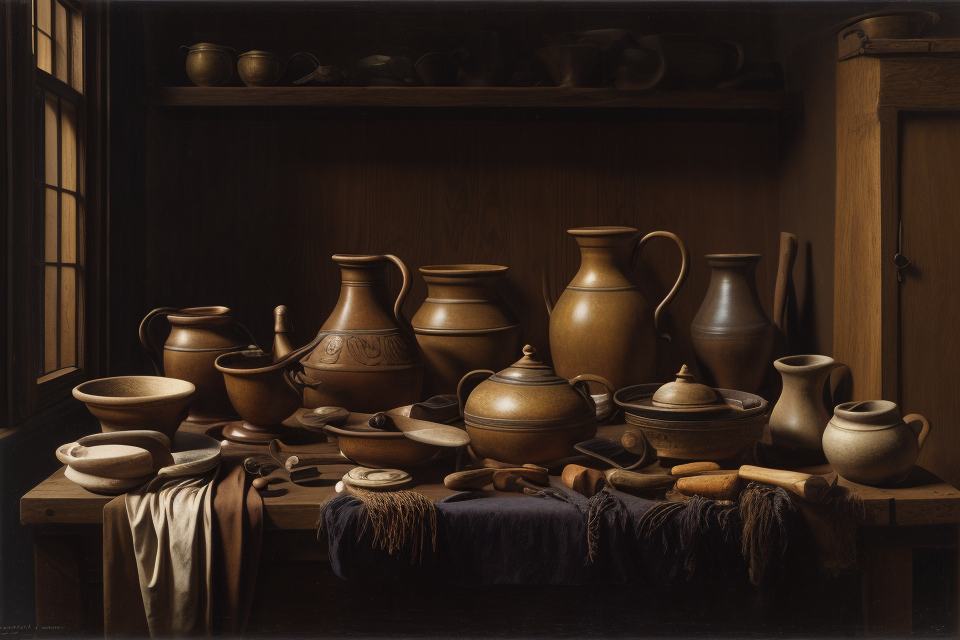
Craftsmanship, a term that brings to mind skilled labor, attention to detail, and a passion for perfection. But what does it truly mean for our lives? Join us as we explore the impact of craftsmanship on our daily experiences, from the way we interact with objects to the sense of satisfaction it brings. We’ll delve into the history of craftsmanship, its connection to our values, and the importance of preserving its traditions in the modern world. Whether you’re a connoisseur of fine art or simply appreciate the beauty of well-made objects, this article will give you a new appreciation for the power of craftsmanship.
What is Craftsmanship?
Definition and Characteristics
Craftsmanship refers to the skill and expertise involved in creating items by hand, often with a focus on aesthetic and functional quality. It encompasses a wide range of activities, from woodworking and metalworking to textiles and pottery. The term also includes the art of repairing and restoring objects, as well as the process of creating custom pieces tailored to a client’s specific needs.
Some key characteristics of craftsmanship include:
- Attention to detail: Craftsmen pay close attention to every aspect of their work, from the materials used to the final finish.
- Pride in workmanship: Craftsmen take pride in their work and strive for excellence in every project they undertake.
- Personal touch: Each piece created by a craftsman is unique, reflecting the individual’s style and approach to the work.
- Tradition and innovation: Craftsmen often draw on traditional techniques and methods while also incorporating new ideas and technologies to create innovative and distinctive pieces.
- Collaboration: Craftsmen often work with clients and other professionals to create custom pieces that meet specific needs and requirements.
Overall, craftsmanship is a highly specialized and skilled profession that requires dedication, creativity, and attention to detail.
The Evolution of Craftsmanship
Craftsmanship has been a vital part of human history since the dawn of civilization. From the earliest tools made by our ancestors to the intricate works of art created today, craftsmanship has been an integral part of our lives. Over time, craftsmanship has evolved and transformed to meet the changing needs and desires of society.
The Early Years
In the early days, craftsmanship was a necessity for survival. People had to create their own tools, weapons, and shelter to survive in a harsh world. Craftsmanship was also used to create art and decorate the world around them. The earliest examples of craftsmanship include cave paintings, bone tools, and pottery.
The Middle Ages
During the Middle Ages, craftsmanship became more specialized, and artisans began to focus on specific skills. The guild system emerged, which allowed artisans to specialize in their craft and pass on their knowledge to apprentices. This led to the creation of highly skilled craftsmen who could create beautiful works of art and functional objects.
The Industrial Revolution
The Industrial Revolution brought about significant changes in craftsmanship. With the rise of factories and mass production, craftsmanship began to lose its prominence. However, there were still artisans who continued to create handmade objects, often in smaller quantities. These artisans were highly skilled and valued for their unique talents.
The Modern Era
In the modern era, craftsmanship has experienced a resurgence. With the rise of the maker movement and the appreciation for handmade objects, craftsmanship has become more valued than ever before. People are once again interested in learning traditional crafts and preserving the skills of the past.
Today, craftsmanship encompasses a wide range of skills, from woodworking and metalworking to textiles and ceramics. Craftsmen and women use traditional techniques and modern materials to create beautiful and functional objects that are appreciated by people all over the world.
Overall, the evolution of craftsmanship reflects the changing needs and desires of society. From its beginnings as a necessity for survival to its current status as a valued art form, craftsmanship has played an important role in shaping our world.
The Importance of Craftsmanship in Our Lives
The Role of Craftsmanship in Personal Development
Craftsmanship, often defined as the skill and dedication put into a piece of work, has been an integral part of human development for centuries. From building structures to creating art, craftsmanship has not only shaped our world but has also played a crucial role in shaping the individuals who create it.
In personal development, craftsmanship serves as a means of self-expression, providing individuals with a platform to hone their skills and creativity. By engaging in craftsmanship, one can experience a sense of fulfillment and pride in their work, which can have a positive impact on their self-esteem and overall well-being.
Additionally, craftsmanship allows individuals to challenge themselves and learn new skills, which can contribute to personal growth and development. The process of learning and perfecting a craft can be a valuable tool for building patience, perseverance, and discipline, all of which are essential qualities for personal development.
Moreover, craftsmanship can provide a sense of connection to a larger community, as individuals can share their work and collaborate with others. This sense of belonging and shared interest can contribute to a stronger sense of identity and purpose, further promoting personal development.
Overall, the role of craftsmanship in personal development is significant and multifaceted. Whether it is through self-expression, skill-building, or community engagement, craftsmanship offers individuals a unique opportunity to grow and develop in a meaningful way.
The Connection Between Craftsmanship and Mental Health
Craftsmanship, or the skill and dedication put into creating something by hand, has long been associated with a sense of satisfaction and fulfillment. But did you know that there’s also a connection between craftsmanship and mental health? Here’s a closer look at the link between the two.
The Therapeutic Benefits of Craftsmanship
Craftsmanship can provide a number of therapeutic benefits for individuals, particularly those struggling with mental health issues. Engaging in a craft can help individuals:
- Reduce stress and anxiety: Focusing on a task can help distract individuals from negative thoughts and feelings, and the rhythmic or repetitive nature of many crafts can be particularly soothing.
- Increase self-esteem: Completing a project can provide a sense of accomplishment and boost self-confidence.
- Improve cognitive function: Many crafts require focus and concentration, which can help improve cognitive function and delay age-related declines in mental abilities.
- Enhance creativity: Craftsmanship often involves problem-solving and innovation, which can help foster creativity and inspire new ideas.
The Role of Craftsmanship in Mental Health Treatment
Craftsmanship is increasingly being recognized as a valuable tool in mental health treatment. Many mental health facilities now offer craft workshops and classes as part of their treatment programs, and some insurance companies are even beginning to cover the costs of craft-based therapies.
Examples of Craft-Based Therapies
There are many different types of craft-based therapies that have been shown to be effective in treating mental health issues. Here are a few examples:
- Art therapy: This involves using art-making to explore emotions, reduce stress, and improve overall mental health.
- Music therapy: This involves using music to improve mood, reduce anxiety, and promote relaxation.
- Writing therapy: This involves using writing as a means of self-expression and reflection, and can be particularly helpful for individuals struggling with trauma or PTSD.
- Pottery therapy: This involves working with clay to create pottery or ceramics, and can be particularly helpful for individuals struggling with depression or anxiety.
Conclusion
While craftsmanship has long been appreciated for its aesthetic and functional benefits, it’s now clear that it also has a powerful impact on our mental health and well-being. By engaging in crafts, we can tap into a range of therapeutic benefits that can help us manage stress, boost self-esteem, and improve cognitive function. And for those struggling with mental health issues, craft-based therapies can provide a valuable tool for healing and recovery.
Craftsmanship in the Workplace
The Value of Craftsmanship in Professions
In today’s fast-paced world, craftsmanship often takes a backseat to efficiency and productivity. However, there is a growing recognition of the value of craftsmanship in professions, particularly in fields such as medicine, law, and engineering.
- Medicine: Surgeons who take the time to meticulously plan and execute their procedures, often achieve better outcomes and patient satisfaction. This attention to detail is not only a testament to the doctor’s technical skills but also their commitment to providing the best possible care for their patients.
- Law: The legal profession is known for its emphasis on attention to detail and precision. Legal drafting is a prime example of the value of craftsmanship. Lawyers who take the time to carefully craft their legal documents, such as contracts and briefs, can ensure that their clients’ interests are protected and that their arguments are presented in the most effective way possible.
- Engineering: In the field of engineering, craftsmanship is often a key factor in the success of a project. Engineers who take the time to carefully design and test their products, can ensure that they are safe, efficient, and reliable. This attention to detail can also lead to innovative solutions that would not have been possible without the focus on craftsmanship.
In all these professions, the value of craftsmanship lies in the fact that it allows practitioners to provide the best possible service to their clients or customers. By taking the time to do things right, these professionals can ensure that their work stands the test of time and that they are building a reputation for excellence.
The Impact of Craftsmanship on Employee Satisfaction and Productivity
Craftsmanship in the workplace has a significant impact on employee satisfaction and productivity. Here are some ways in which craftsmanship can influence these aspects of work:
- Sense of accomplishment: When employees are involved in tasks that require craftsmanship, they often experience a sense of accomplishment. This feeling can boost their self-esteem and increase their motivation to do a good job. As a result, they may be more satisfied with their work and feel more engaged in their tasks.
- Increased focus: Craftsmanship requires concentration and attention to detail. When employees are involved in tasks that require craftsmanship, they are more likely to focus on their work. This increased focus can lead to better productivity and higher quality work.
- Improved teamwork: Craftsmanship often involves collaboration and teamwork. When employees work together to achieve a common goal, they can build trust and rapport with one another. This can create a positive work environment and lead to improved communication and collaboration among team members.
- Job satisfaction: When employees are involved in tasks that require craftsmanship, they often feel a sense of pride in their work. This can lead to increased job satisfaction and a greater sense of purpose in their work. When employees feel more fulfilled in their jobs, they are more likely to stay with their employer and be more productive.
Overall, craftsmanship in the workplace can have a positive impact on employee satisfaction and productivity. By incorporating craftsmanship into the workplace, employers can create a more fulfilling and engaging work environment, which can lead to improved employee retention and higher productivity.
Craftsmanship in Society
The Cultural Significance of Craftsmanship
Throughout history, craftsmanship has played a crucial role in shaping human culture and society. From ancient civilizations to modern times, the skill and artistry of craftsmen have left an indelible mark on the world around us. This section will explore the cultural significance of craftsmanship and its impact on society.
- Preservation of Traditions: Craftsmanship has long been a means of preserving cultural traditions and heritage. Artisans often pass down their skills and knowledge to future generations, ensuring that traditional techniques and designs are not lost. For example, in Japan, the art of paper-cutting has been preserved for centuries by the Ogasa community, who continue to create intricate designs using this traditional craft.
- Social and Economic Development: Craftsmanship has also played a significant role in social and economic development. In many developing countries, craftsmanship provides an essential source of income for artisans and their communities. The promotion and sale of handmade goods not only support local economies but also help preserve cultural heritage and traditions.
- Personal Fulfillment: For many craftsmen, their work represents a deep sense of personal fulfillment and satisfaction. Craftsmanship often requires patience, dedication, and attention to detail, making it a highly rewarding pursuit. Craftsmen often find a sense of purpose and pride in their work, which can lead to increased self-esteem and a sense of accomplishment.
- Aesthetic Appreciation: The beauty and elegance of craftsmanship are also a significant aspect of its cultural significance. Artisans often spend countless hours perfecting their techniques and designs, resulting in works of art that are highly valued by collectors and admirers alike. The appreciation of craftsmanship transcends cultural boundaries and serves as a means of connecting people across the globe.
- Emotional Connection: Craftsmanship also has the power to evoke emotions and create a sense of connection between people. Handmade items often carry a story or memory, making them cherished possessions that can be passed down through generations. This emotional connection to craftsmanship can create a sense of belonging and shared history among communities.
Overall, the cultural significance of craftsmanship is vast and far-reaching. It encompasses the preservation of traditions, social and economic development, personal fulfillment, aesthetic appreciation, and emotional connection. By exploring these various aspects, we can gain a deeper understanding of the impact that craftsmanship has on our lives and the world around us.
The Role of Craftsmanship in Building Communities
Craftsmanship has played a vital role in building communities throughout history. From the construction of monumental structures to the creation of everyday objects, craftsmanship has been instrumental in bringing people together and fostering a sense of belonging. In this section, we will explore the various ways in which craftsmanship contributes to community building.
Creating a Sense of Identity
Craftsmanship often reflects the values, beliefs, and traditions of a community. The skills and techniques employed in crafting objects are passed down from generation to generation, creating a sense of continuity and pride in one’s heritage. As a result, craftsmanship can serve as a means of preserving and celebrating a community’s unique identity.
Promoting Social Interaction
The process of crafting objects often involves collaboration and social interaction. Artisans and craftspeople work together, sharing knowledge and techniques, and relying on one another to complete complex projects. This collaborative nature of craftsmanship can help to build strong social bonds within a community, fostering a sense of cooperation and mutual support.
Encouraging Skill Development
Craftsmanship is not only about creating beautiful objects but also about developing skills and expertise. The pursuit of excellence in craftsmanship requires dedication, patience, and a willingness to learn from one’s mistakes. By engaging in craftsmanship, individuals can develop valuable skills that translate to other areas of their lives, such as problem-solving, perseverance, and attention to detail.
Supporting Local Economies
Craftsmanship can also play a crucial role in supporting local economies. Artisans and craftspeople often rely on local materials and resources, which helps to sustain the environment and promote economic growth within the community. Additionally, the demand for handmade objects can create job opportunities and contribute to the overall prosperity of a community.
In conclusion, craftsmanship has a profound impact on our lives and the communities we belong to. By fostering a sense of identity, promoting social interaction, encouraging skill development, and supporting local economies, craftsmanship plays a vital role in building strong, resilient communities.
Craftsmanship and Sustainability
The Relationship Between Craftsmanship and Environmentalism
The relationship between craftsmanship and environmentalism is a complex one, but it is undeniable that craftsmanship can play a crucial role in promoting sustainability. By focusing on the use of natural materials, traditional techniques, and local expertise, craftsmanship can help to reduce waste, conserve resources, and support local economies.
One way in which craftsmanship contributes to environmentalism is through the use of natural materials. Many craftspeople work with materials that are locally sourced and renewable, such as wood, textiles, and ceramics. By using these materials, craftspeople can help to reduce the demand for non-renewable resources and promote sustainable practices.
Traditional techniques used in craftsmanship can also play a role in promoting sustainability. These techniques often involve minimal waste and are designed to make the most of available resources. For example, traditional woodworking techniques involve using every part of the tree, from the trunk to the branches, to create a variety of products. This approach reduces waste and helps to conserve resources.
Finally, craftsmanship can support local economies and promote social sustainability. By working with local artisans and supporting local businesses, craftsmanship can help to preserve traditional knowledge and skills, while also providing employment opportunities and supporting community development.
In conclusion, the relationship between craftsmanship and environmentalism is a multifaceted one, but it is clear that craftsmanship can play a significant role in promoting sustainability. By using natural materials, traditional techniques, and supporting local economies, craftsmanship can help to reduce waste, conserve resources, and promote social sustainability.
The Future of Craftsmanship in a Sustainable World
As the world continues to grapple with the challenges of climate change and environmental degradation, the role of craftsmanship in promoting sustainability has become increasingly relevant. The future of craftsmanship in a sustainable world will likely be shaped by a number of factors, including the rise of eco-friendly materials, the growing demand for ethical and sustainable products, and the increasing importance of local and traditional crafts.
One of the key trends in the future of craftsmanship is the use of eco-friendly materials. As consumers become more conscious of the environmental impact of their purchases, there is a growing demand for products that are made from sustainable materials. This has led to an increase in the use of materials such as bamboo, recycled metals, and organic cotton in craftsmanship. These materials not only reduce the environmental impact of production, but also offer unique aesthetic qualities that can enhance the beauty and functionality of handmade products.
Another important trend is the growing demand for ethical and sustainable products. As consumers become more aware of the social and environmental impact of their purchases, they are increasingly seeking out products that are made using fair labor practices and sustainable production methods. This has led to a renewed interest in traditional crafts, which often prioritize community involvement and environmental stewardship. In the future, craftsmanship is likely to play an increasingly important role in promoting ethical and sustainable production practices.
Finally, the future of craftsmanship in a sustainable world will also be shaped by the increasing importance of local and traditional crafts. As globalization continues to homogenize many aspects of modern life, there is a growing appreciation for the unique cultural heritage of local communities. This has led to a renewed interest in traditional crafts, which often reflect the history and traditions of a particular region or community. In the future, craftsmanship is likely to play an important role in preserving and promoting the cultural heritage of local communities, while also promoting sustainable production practices.
Overall, the future of craftsmanship in a sustainable world is likely to be shaped by a number of factors, including the use of eco-friendly materials, the growing demand for ethical and sustainable products, and the increasing importance of local and traditional crafts. As the world continues to grapple with the challenges of climate change and environmental degradation, craftsmanship has the potential to play an important role in promoting sustainable production practices and preserving the cultural heritage of local communities.
The Enduring Legacy of Craftsmanship
The enduring legacy of craftsmanship can be seen in the way it has influenced the way we think about sustainability. The concept of sustainability has been a growing concern in recent years, as people have become more aware of the impact of their actions on the environment. Craftsmanship plays a crucial role in this by promoting the use of sustainable materials and techniques.
One way that craftsmanship has influenced sustainability is through the use of natural materials. Many traditional crafts rely on materials that are readily available in nature, such as wood, stone, and fabric. These materials are renewable and require little energy to produce, making them a sustainable choice for craftsmen.
Another way that craftsmanship has impacted sustainability is through the promotion of local and regional production. In many cases, crafts are produced in small workshops or by individual craftsmen, who source their materials locally. This reduces the need for transportation and the associated carbon emissions, making the production process more sustainable.
Craftsmanship has also influenced sustainability through the promotion of long-lasting and durable products. Crafts are often made to last for many years, if not centuries, and are designed to be repaired and restored rather than discarded. This emphasis on longevity reduces the need for constant consumption and waste production, which is a key aspect of sustainability.
Overall, the enduring legacy of craftsmanship can be seen in the way it has promoted sustainable practices and values. By using natural materials, promoting local production, and emphasizing durability, craftsmanship has contributed to a more sustainable way of life.
The Importance of Preserving Craftsmanship for Future Generations
In today’s fast-paced world, craftsmanship is often overlooked and undervalued. However, preserving craftsmanship is crucial for future generations, as it is an integral part of our cultural heritage and provides numerous benefits.
- Preserving Cultural Heritage: Craftsmanship is a vital part of our cultural heritage, and preserving it helps to maintain the identity and traditions of different communities. By preserving craftsmanship, we can ensure that future generations can continue to appreciate and learn from our cultural history.
- Economic Benefits: Craftsmanship also provides economic benefits, as it creates jobs and supports local economies. In addition, handmade products often command a premium price, which can benefit artisans and their communities.
- Sustainable Production: Craftsmanship is often associated with sustainable production methods, as it often involves using locally sourced materials and traditional techniques that are less harmful to the environment than modern industrial methods. By preserving craftsmanship, we can promote sustainable production practices that benefit both the environment and local communities.
- Personal Satisfaction: Finally, preserving craftsmanship can provide personal satisfaction and a sense of accomplishment for those who practice it. By learning a traditional craft, individuals can develop a sense of pride in their work and pass on their skills to future generations.
In conclusion, preserving craftsmanship is essential for future generations, as it helps to maintain our cultural heritage, provides economic benefits, promotes sustainable production, and provides personal satisfaction. Therefore, it is important to support and promote craftsmanship in our communities and encourage future generations to continue this valuable tradition.
FAQs
1. What is craftsmanship?
Craftsmanship refers to the skill and expertise required to create items by hand, often with a focus on quality and attention to detail. It involves a combination of technical knowledge, creativity, and patience to produce something that is not only functional but also aesthetically pleasing.
2. How does craftsmanship impact our lives?
Craftsmanship has a significant impact on our lives in many ways. For one, it can provide us with beautiful and well-made objects that we can use and enjoy on a daily basis. Additionally, the process of creating something by hand can be therapeutic and fulfilling, offering a sense of accomplishment and pride in one’s work. Finally, craftsmanship can also contribute to the preservation of cultural traditions and history, as many crafts are passed down from generation to generation.
3. What are some examples of craftsmanship?
There are many examples of craftsmanship, ranging from traditional crafts like woodworking, pottery, and weaving to more modern crafts like metalworking, leatherworking, and even digital design. Each of these crafts requires a unique set of skills and techniques, and each can produce beautiful and functional objects that enrich our lives.
4. Is craftsmanship still relevant in today’s world?
Absolutely! While technology has certainly changed the way we live and work, there is still a place for craftsmanship in our lives. In fact, many people are drawn to handmade objects and traditional crafts as a way to slow down and connect with the past. Additionally, the rise of maker culture and DIY movements has helped to revive interest in craftsmanship and hands-on creativity.
5. How can I learn more about craftsmanship?
There are many resources available for those interested in learning more about craftsmanship. You can start by reading books and articles on the subject, attending workshops and classes, or joining online communities of craftspeople and enthusiasts. Additionally, many museums and art galleries feature exhibits on traditional and contemporary crafts, providing a great opportunity to see and learn about beautiful handmade objects firsthand.







